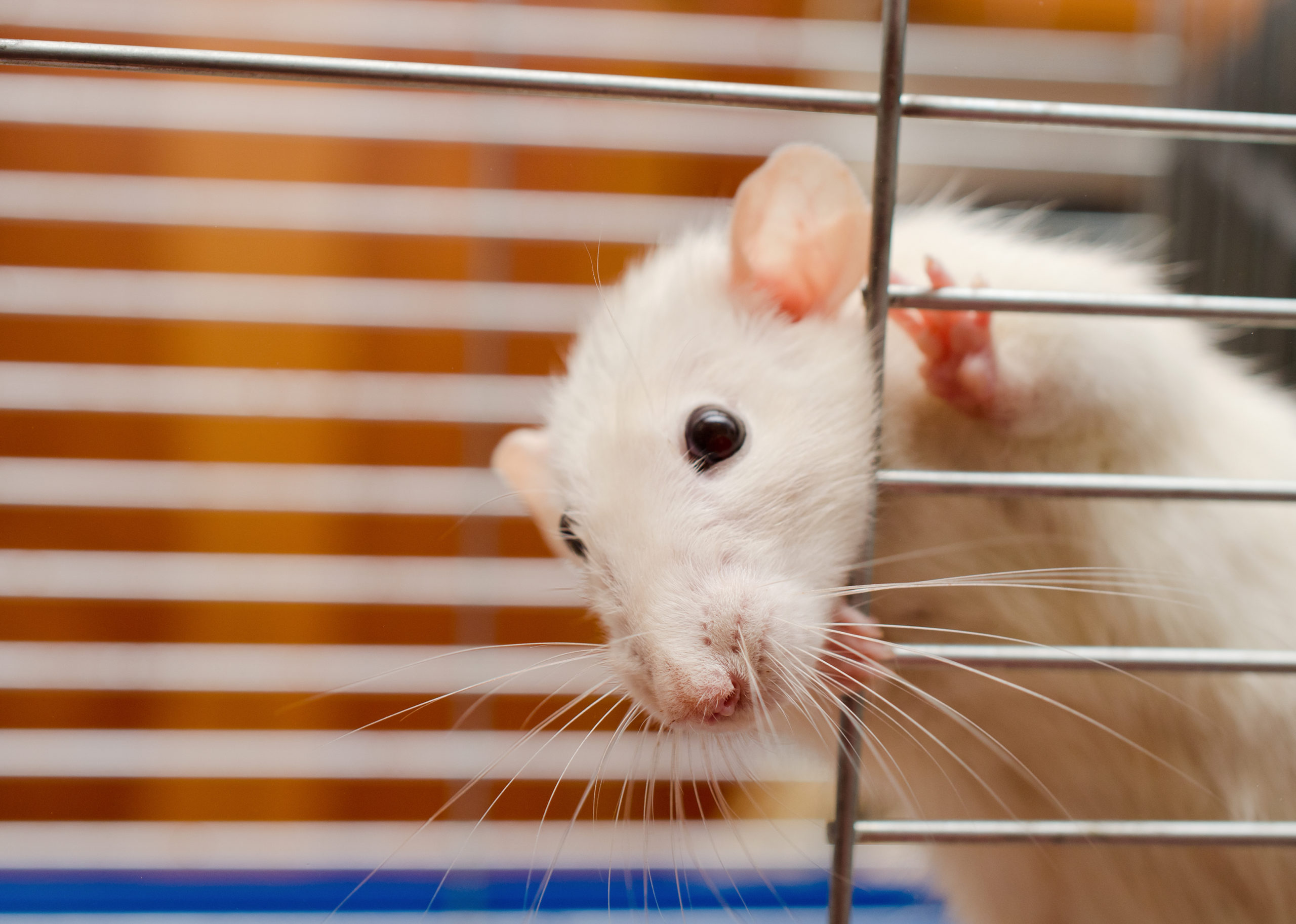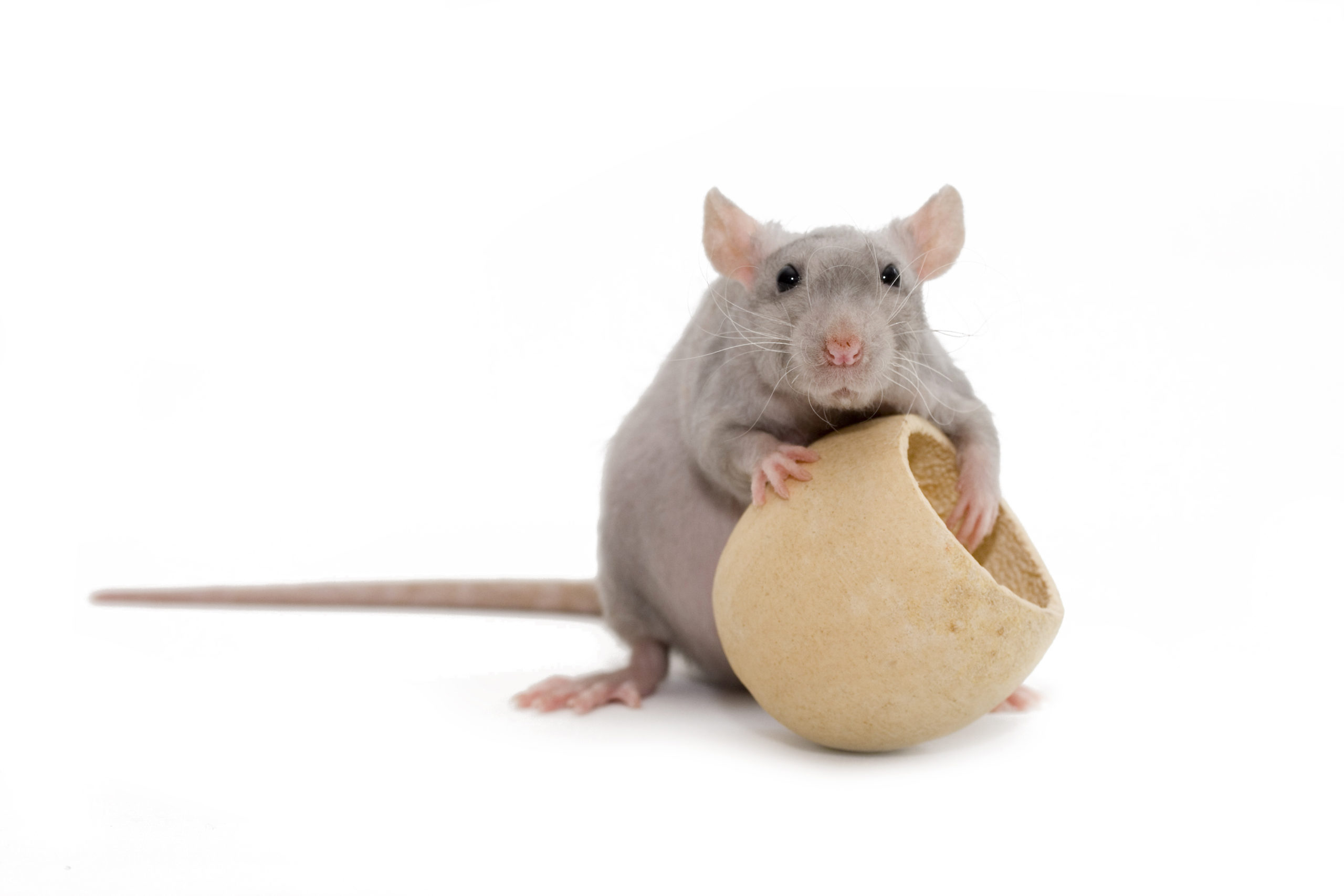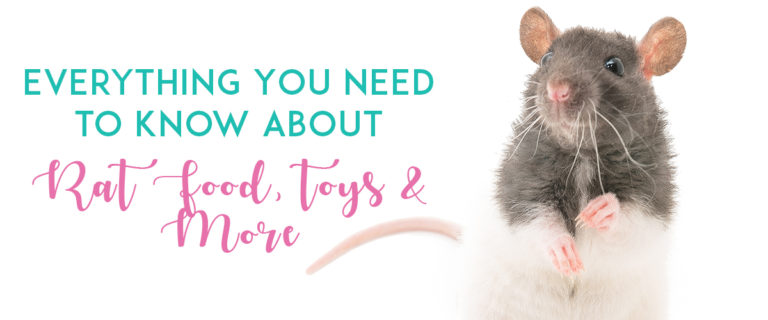Rats are some of the most intelligent, loyal, and curious small animals. They really are. And if you’re lucky enough to welcome a rat into your family, you’ll easily see why these little guys and gals are such a favorite. Whether you’re bringing a rat into your home for the first time or want to learn more on how to care for your rat, read on. We’re gonna talk rat food, rat toys and rat cages.
Let’s get started by setting up your new rat’s home.
Find the Perfect Rat Cage
Your rat’s cage is where he or she will call home when you’re not around, so let’s make it totally perfect. Most experts recommend having at least two square feet of floor space per rat. Because they’re very social creatures and do well in pairs, if you have two rats, consider finding a cage that has at least four square feet of cage space. If you prefer to give more space, that’s definitely okay, too.

Rats love to climb, run, and explore. Cages with multiple levels provide entertainment and exercise for your little ones. You might also want to install an exercise wheel so they can run and run all night. But do your research. Make sure the wheel is large enough for your rat; small wheels are notorious for causing back problems. If the wheel causes your rat to arch his back downwards, it’s too small. Opt for a bigger option or provide a different form of exercise.
Wire cages are ideal for rats because they love to chew, and wire will withstand those big chompers. Also, wire cages provide adequate ventilation, which is super important. Could you imagine being stuck in a big glass tank, not getting enough fresh air? Yeah, us either. Make sure that your wire cage has a solid bottom. Wire bottoms are dangerous; it’s possible for your rat to get their foot or leg stuck in an opening, no matter how small. Plus, wire flooring puts a lot of pressure in one place on the foot, which can cause a chronic infected open sore called bumble foot. Solid is definitely best.
Bedding for Your Rat
Your rat’s cage requires clean and comfortable bedding and litter. Rats are super tidy animals and giving them high-quality paper, hay, or wood bedding makes it easier for them to keep their house clean. Search for a bedding that is natural, dye-free, and rat-safe. For the most comfortable home for your rat, keep their bedding and food areas separate and change the bedding every week or so. (Depending on how many rats you have. The more you have, the more it'll need to be changed.) Remember that bacteria starts working immediately on urine, changing it to ammonia. Prolonged exposure to ammonia can damage your rat’s respiratory tract. If you’re smelling a stench, you’re not cleaning often enough and it’s time to re-visit the cleaning schedule.
It’s Always Playtime With These Rat Toys
Don’t forget the toys in your rat’s cage. Again, rats love to chew and explore. Simple things like crinkle balls provide hours of fun, or you can give them natural toys and chews like hanging wood mobiles and fun hay twists to chomp on.

Where to Place Your Rat’s Cage
Lastly, where you place your rat’s cage matters. Rats are sensitive to extreme temperatures and drafts, so make sure the room where your rat will live stays between 60 and 80 degrees Fahrenheit. You’ll also want to keep your little friend away from any vents that might produce a draft. Rats like dry, warm areas away from direct sunlight and loud noises. They are nocturnal, so expect your rat to sleep during the day and want to play at night. Socializing your rat during these hours will quickly strengthen your bond.
Get Munching on Rat Food
If there’s one thing rats love doing, it’s eating! Always make sure your rat has fresh food and water available. You can also share a treat with your rat, as long as it’s on the list of safe rat food. Read on to learn more about feeding your little guy or gal.
What to Feed Your Rat
If you’re like most parents, you’ll likely feed your rat pelleted rat food. Pellets or blocks are perfectly balanced for your little critter and have everything they need to be happy and healthy. As we already know, rats love to chew, so these crunchy foods give your rat something to do, in addition to being nutritious and delicious.
You might also consider a rat food medley, which has a bunch of healthy seeds. But, sometimes picky rats will pick out their favorites and leave the rest. This can lead to a nutrition deficit, so the pellets and blocks are sometimes a better choice.
When shopping for your rat’s food, make sure to read the label. Many commercial foods have added sweeteners which can lead to a chubby rat… and no one wants that. Find rat food that only contains natural ingredients, like seeds or hay, to make sure they are eating a balanced diet. A high-quality rat food will help them feel their best.
How Much Should I Feed My Rat?
Asking “how much food should I feed my rat?” is really difficult because just like humans; the answer depends on your rat’s sex, size, age and eating habits.
Babies will eat a lot of rat food as they grow into adulthood, and adult rats should be fed enough food to maintain a healthy weight. As a general rule, start by feeding your rat about a half ounce to three-quarters of an ounce twice a day. If you notice that your rat quickly eats all of the food, they probably need more. If you see that you’re throwing away a lot, or your rat is getting a little chubby, scale it back. A healthy adult male rat will weigh approximately 0.77 to 1.43 lbs.
A helpful trick to gauge your rat’s weight is to look at their tail. If you notice that your rat’s tail is square around the edges of the base, he or she might be underweight. Healthy rats have nice, thick, rounded tails.
Safe Rat Food & Treats
In addition to your rat’s pellets, they definitely enjoy the occasional treat. You can supplement your rat’s food with fresh fruits, veggies, and whole grains for a snack that’s sure to make your rat love you. There’s no better way to bond with your pet than by sharing a healthy snack together.
Not sure what to treats to offer? Here are safe rat foods for your friend (in moderation, of course):
- Apples 🍎🍏
- Cherries 🍒
- Grapes 🍇
- Bananas 🍌
- Strawberries 🍓
- Other berries
- Broccoli 🥦
- Potatoes
- Peas
- Carrots 🥕
- Squash
- Whole wheat pasta and bread 🍜🍞
- Cooked beans
- Yogurt
- Brown rice
- Nuts (in moderation and as long as they aren’t too fatty)
- Mealworms
You can feed your rat the leafy greens above once a day. Feed them proteins (like cooked chicken or ham) twice a week, and the occasional fruit once or twice a week.
Rat Food to Avoid
Sharing a snack with your rat is fun, as long as it’s a healthy one. Avoid these rat foods when thinking about what to feed your friend:
- Any type of sugar (chocolate, candy, etc.)
- Caffeine
- The skin, leaves or seeds on veggies like tomatoes, beets, and avocados
- Hamster food
- Mango
- Citrus fruits
- Anything moldy (like blue cheese)
- Dried beans or corn (cook them first)
- Peanuts or peanut butter
- Spinach
- Raw sweet potatoes
- Raw onions
Other Things to Know to When Taking Care of a Rat
We’ve learned a lot about rats, from setting up their home to their favorite foods. But there’s so much more to learn about these personable animals. Here are some of our favorite facts about rats:
- They’re easily trainable. They are extremely smart and can be litterbox trained and trained to be held and socialized.
- They love having a companion. Two female rats usually do well together, or two male rats that are both fixed.
- They love puzzles to keep their mind sharp.
- They can live up to four years.
Is a Pet Rat Right for Me?
Rats are fun additions for families who have enough time to socialize and bond with them, don’t mind keeping their cage clean, and want a low maintenance, affordable pet. They get along with children and other animals when trained, and can be your loyal companion for years.
If you travel a lot or are away from home, don’t want to worry about cleaning a cage, or will be disrupted by their nocturnal behavior, a rat might not be for you. Make sure you do your research before committing. These little critters deserve a home full of love, toys, and snacks, so make sure you’re totally ready before you get one. Best of luck!
Interested in learning more about rats? Check out these blogs! ⬇️⬇️⬇️
Wanna Make Your Rat Healthier? Here Are 5 Things You Should Do.





